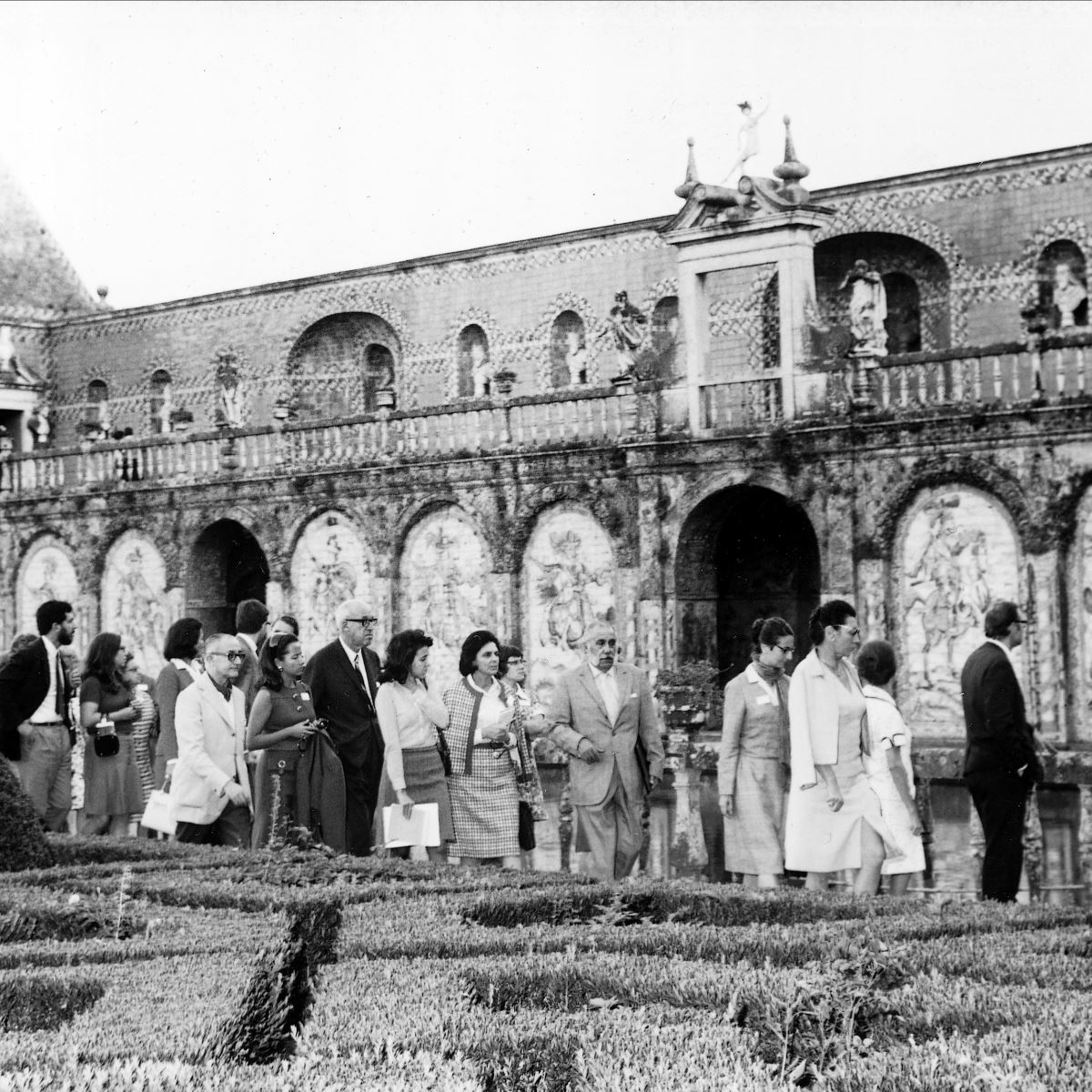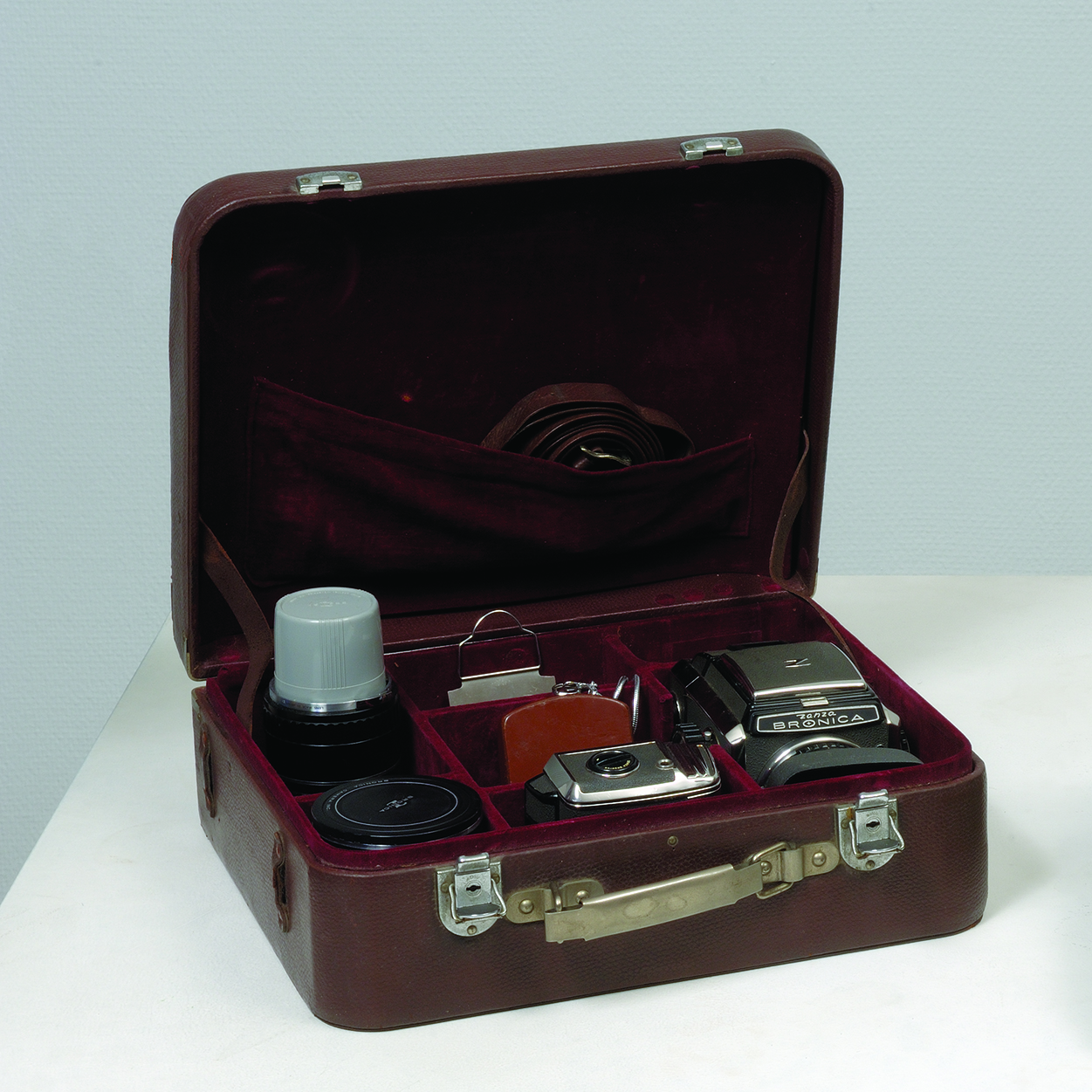HISTORY: Biographical note
We have no hesitation in stressing the importance of João Miguel dos Santos Simões in imposing a "before and after" in relation to the history of research into the glazed decorative tile. His fundamental contribution in such crucial areas as, for example, inventory and research and the way in which he conquered a specific place for the tile in the History of Portuguese Art were decisive for the development of the study of tiles in Portugal.
João Miguel dos Santos Simões was born in Lisbon in 1907 into a family that enjoyed close connections with culture: his father José Rodrigues Simões had built up an impressive library and was, for some time, the treasurer of the Association of Archaeologists. Living in this environment, the young Santos Simões came into regular contact with leading figures from the world of the History of Art, such as Garcez Teixeira and Vergílio Correia. However, the person who had the greatest influence upon him was José Queiroz, a highly regarded student of ceramics, whom he held in great affection and who, together with his father, helped to develop his sensitivity towards artistic matters.
Due to the fact that his father owned a textile spinning mill in Tomar, he studied Textile Engineering at the École Superieure de Filature et Tissage in Mulhouse in 1929 and trained in the cotton industry, at various places across Europe. However, his artistic interests always accompanied him on his travels throughout the main European cities, visiting monuments and museums and consolidating his knowledge in the History of Art. Hence, as early as 1942, he had published his first study on tiles in the magazine A Cidade de Évora.
1944 marked a turning point in his career as a student of ceramic tiles, not only because of his theoretical studies in Madrid but also because of the practical experience gained at the Fábrica Ruiz de la Luna, where he learned all about the technical processes involved in tile production. This was to have a decisive influence upon his later development as, at his home in Tomar, he set up a small laboratory for examining and testing ceramic bodies. This technical dimension and the systematisation of the knowledge he had inherited from his exposure to scientific methods were applied to the study of tiles, with this approach proving crucial for his establishment of a typology that is still used today among those engaged in research in this field.
From 1944 onwards, his studies on Portuguese tiles continued apace and he became the specialist with the greatest international notoriety. His published works in this area included: Antwerpesche tegels van omstrecks 1558 in Portugal, in which he collaborated with van Herck on the work Antwerpens Koninklike Oudheidkundige Kring; Maioliche flamminghe e spagnole in Portogallo, for the magazine Faenza; Le role de la décoration céramique dans l’architecture portugaise dês XVII-XVIII siécles, published in the proceedings of the XVI Congrés International d’Histoire de l’Art; the award-winning book Le carreaux ceramiques hollandais au Portugal et en Espagne; and an important contribution towards the Fliesen with articles such as The tiles of Spain and Portugal and The influence of Dutch tiles in Portugal and Brasil. In view of the work he left behind, the name of Santos Simões is still a watchword even today in studies on tiles and ceramics, both in Portugal and abroad. There is no doubt that he left us with the legacy of having done so much to promote tiles as a distinct and identifying hallmark of Portuguese culture.
Selection of texts about Santos Simões
HENRIQUES, Paulo – O Homem de Hoje – João Miguel dos Santos Simões. In João Miguel dos Santos Simões 1907–1972. Lisboa: Ministério da Cultura / Instituto Português de Museus / Museu Nacional do Azulejo, 2007, p. 13–22. [no English version available]
MONTEIRO, João Pedro – Teórico e Historiador do Azulejo em Portugal. In João Miguel dos Santos Simões 1907–1972. Lisboa: Ministério da Cultura / Instituto Português de Museus / Museu Nacional do Azulejo, 2007, p. 31–48. [no English version available]
Santos Simões by Vitor Serrão
João Miguel dos Santos Simões, collector of interests and knowledge:
Art History and the full rehabilitation of the azulejo (2009)
We owe João Miguel dos Santos Simões (1907-1972) a new and enlightened understanding of the azulejo as an integral part of Portugal’s artistic identity, as well as the acknowledgement of its international relevance.
The highly prestigious and pioneering works of this great art historian endowed azulejo studies with a new methodology and a wider, non-formalist (and least of all rigid or biased) vision. Through Simões’ research, the azulejo was finally recognized as a superior art form, no longer associated with “the petty label ‘movable ceramics’” under which it had long been classed, and came to be admired as an autonomous artistic practice. Simões’ work as a collaborator, since 1947, at the National Museum of Ancient Art allowed him to put together, through a patient effort that lasted several years, a monumental catalogue of Portuguese tiles (published by the Calouste Gulbenkian Foundation in various volumes, from 1966 onwards). This work was instrumental in revealing the azulejo as one of the most remarkable and original elements of Portugal’s historical and artistic heritage, from the 15th century to the present.
According to Paulo Henriques, the former director of the National Azulejo Museum, “João Miguel dos Santos Simões’ methodology owes more to the exact sciences than to the humanities.” This aspect of his training allowed him, ever since the 1950s, to bypass the strict conventions that used to dominate Art History and pave the way for a more objective research, oriented towards specific goals, combining technical, laboratorial, iconographic, historical, comparative and aesthetic insights. The specificity of his “way of seeing” led to a vast bibliographic output and, above all, to the consolidation of a globalizing outlook on the “artistic fact”. The work of many scholars who followed Simões’ example – particularly José Meco, from the late 1970s on – would not have been possible without the high-quality methods and analytical approaches he introduced.
The azulejo’s scenographic impact, the ability to animate architectural spaces (see the full patterned coverings from the 18th century), the skilful execution (see the works by António de Oliveira Bernardes), the close dialogue with other art forms (see the intimate and felicitous interactions with gilt woodwork, sculpture, grotesque painting or garden architecture) and the close relationship with light, water and other natural elements are some of the features that make azulejo coverings a major Portuguese art form, with a very strong presence in other Portuguese-speaking regions. The studies on azulejos published since the 1980s – and especially the ones promoted by the National Azulejo Museum, those authored by José Meco and those resulting from research projects and ongoing work by the members of the João Miguel dos Santos Simões Thematic Network for the Study of Azulejos and Ceramics (RTEACJMSS)*, coordinated by Susana Varela Flor and Rosário Salema de Carvalho – have helped consolidate a line of research whose strategic definition and critical focus lead back to the work of Santos Simões.
Santos Simões’ trademark feature was always his discipline, combined with a unique passion for learning, witnessed by his colleagues and admirers – from art historians such as Adriano de Gusmão, Flávio Gonçalves, Mário Chicó, Artur Nobre de Gusmão, Túlio Espanca, Nogueira Gonçalves, Mário Barata, Dora Alcântara, Yves Bottineau and George Kubler to artists like Almada Negreiros, Sarah Afonso, Eduardo Nery and Querubim Lapa, and to museologists like João Couto and Rafael Salinas Calado, among many others – in Portugal and abroad. Recognized early on for his modern approach, developed during his travels across Europe and his study in England (which led, in Tomar, to the friendly nickname “Factory John”), Santos Simões was an erudite, cosmopolitan and knowledgeable traveller, whose informed and up-to-date worldview allowed him to set clear life and research goals. His training in textile engineering (with a degree obtained in France in 1929), his specialization at Manchester’s College of Technology, his experience as the manager of his father’s spinning mill, in Tomar, and his numerous field trips to England, Italy, Germany, Switzerland, Austria, the Netherlands, Belgium, Hungary, Czechoslovakia and the United States all contributed to the groundbreaking nature of his work both as an art historian and a museologist. However, his interests as a “good man” and a scientist “unattached to material possessions” were various and went far beyond his love for azulejos: he also founded the Portuguese Ski Club, in Serra da Estrela, brought the board game “Monopoly” over from the United States, created the Group of Friends of Windmills, was a caravanning enthusiast, etc.
The commemorations of Santos Simões’ centenary, in 2007, included a large-scale monographic exhibition at the National Azulejo Museum, and this museum was also entrusted with his personal archive, donated by his heirs. At the time, questioned by the journalist José Vítor Malheiros about the absence of azulejos among the folders, notebooks and books that were donated (Público, 17 July 2007), his daughter Maria João Real claimed that her father “was a scholar, not a collector; or rather, a collector of interests and knowledge”… The definition is accurate: Santos Simões was in fact an art historian with a far-reaching vision, who was able, like very few before him, to carry out a continuous work based on new concepts and an adequate methodology. Few Portuguese authors can be credited with having opened as many doors to the development of Art History and the rehabilitation of the country’s artistic heritage.
* currently Az – Azulejo Research Network

Santos Simões at a conference organized by the Calouste Gulbenkian Foundation, Lisbon, 1968

Visit to the Fronteira Palace, in Lisbon, during the 1st International Symposium on Azulejos, 1971

Santos Simões’ camera
